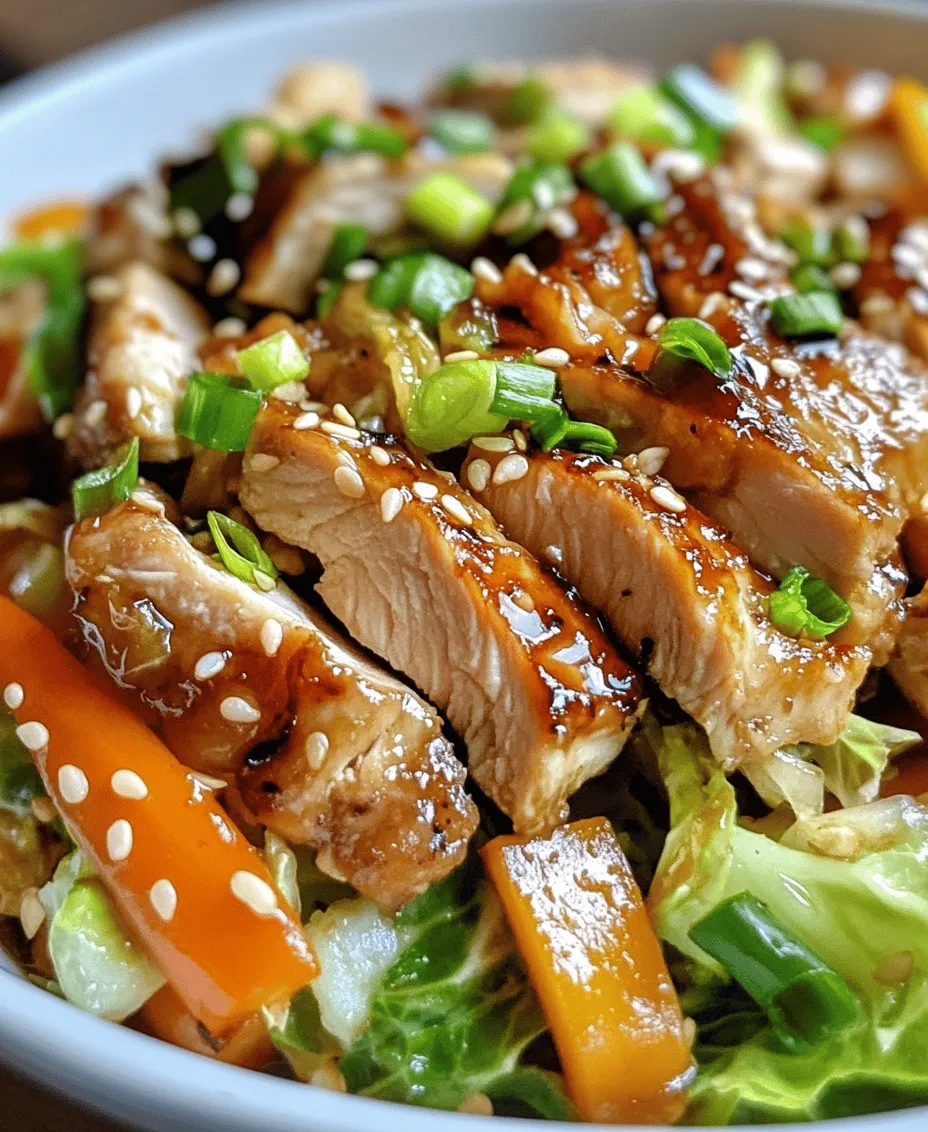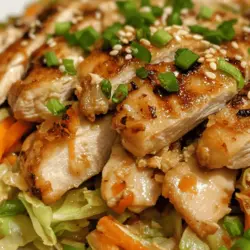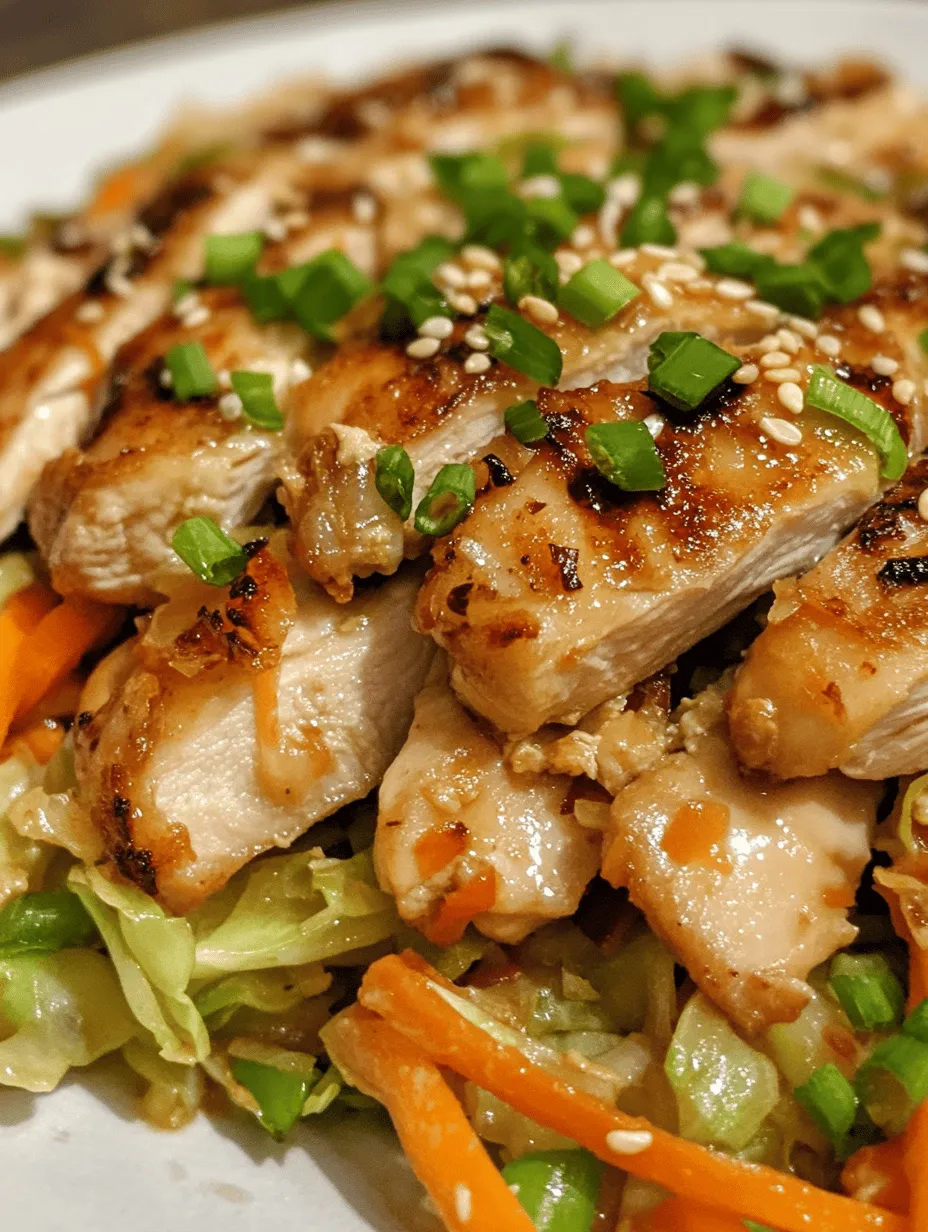In the world of quick and easy weeknight dinners, few dishes can compete with a savory Chinese Chicken Cabbage Stir-Fry. This delightful recipe is not only packed with flavor but also loaded with nutritious ingredients that will satisfy your cravings without compromising your health. Perfect for busy families or individuals looking for a satisfying meal in under 30 minutes, this stir-fry combines tender chicken thighs with vibrant vegetables, creating a colorful and appetizing dish. In this article, we will explore the intricacies of preparing this delicious stir-fry, discuss its nutritional benefits, and share insights into the cultural significance of the ingredients used.
Understanding the Ingredients
Chicken Thighs: Why They Are Preferred Over Breast Meat
When it comes to stir-frying, choosing the right cut of chicken is crucial for both flavor and texture. Chicken thighs are often preferred over chicken breast due to their higher fat content, which contributes to a more succulent and flavorful dish. Unlike chicken breast, which can easily dry out when cooked quickly at high temperatures, thighs retain moisture and tenderness, making them ideal for stir-frying. Additionally, they have a richer flavor that complements the savory sauces typically used in Chinese cuisine.
The Role of Cabbage: Nutritional Benefits and Varieties
Cabbage is a key player in this stir-fry, providing both texture and nutrition. This cruciferous vegetable is low in calories yet high in vitamins C and K, fiber, and antioxidants. It also promotes digestive health and may have anti-inflammatory properties. There are various types of cabbage you can use, from green and red cabbage to Napa cabbage, each offering a unique flavor and texture. Napa cabbage, with its delicate leaves, is particularly popular in Asian cuisine and adds a subtle sweetness to the dish.
Carrots and Bell Peppers: Color, Flavor, and Health Benefits
Adding carrots and bell peppers not only enhances the visual appeal of your stir-fry but also boosts its nutritional profile. Carrots are rich in beta-carotene, which is converted to vitamin A in the body, promoting healthy vision and skin. Bell peppers, especially the red and yellow varieties, are loaded with vitamin C and antioxidants. Their sweet crunch elevates the flavor of the dish, making each bite a delightful experience.
Aromatics: The Importance of Garlic and Ginger in Chinese Cuisine
No stir-fry is complete without the aromatic duo of garlic and ginger. These ingredients form the backbone of many Chinese dishes, infusing the stir-fry with depth and complexity. Garlic adds a pungent flavor that elevates the dish, while ginger introduces a warm, zesty note. Together, they create a harmonious balance that is essential in Chinese cooking. Additionally, both garlic and ginger offer numerous health benefits, including anti-inflammatory properties and potential immune system support.
Sauces and Oils: Understanding Soy Sauce, Oyster Sauce, and Sesame Oil
The sauces and oils you use in your stir-fry play a critical role in flavor development. Soy sauce is a staple in Chinese cuisine, providing a salty, umami flavor that enhances the overall taste of the dish. Dark soy sauce adds richness and color, while light soy sauce contributes a more delicate saltiness. Oyster sauce, made from oyster extracts, adds a hint of sweetness and depth. Finally, a drizzle of sesame oil at the end of cooking brings a nutty aroma that ties everything together.
Marinating the Chicken
The Importance of Marination in Flavor Development
Marinating the chicken is a crucial step that enhances both flavor and tenderness. A simple marinade typically consists of soy sauce, a bit of sesame oil, and cornstarch, which helps to tenderize the meat while allowing it to absorb the flavors of the sauce. The cornstarch also creates a light coating around the chicken, ensuring a crispy texture when cooked.
Suggested Marination Times for Optimal Flavor
For optimal flavor, marinate the chicken thighs for at least 30 minutes, although longer marination times of up to 2 hours can yield even better results. If you’re short on time, even a quick 10-minute marinade can make a difference. Just remember, the longer the chicken marinates, the more intense the flavor will be.
Preparing the Vegetables
Techniques for Efficient Vegetable Preparation
Preparing the vegetables efficiently will save you time and ensure that your stir-fry cooks evenly. For cabbage, start by removing any wilted outer leaves and then slice it into quarters. From there, finely shred the cabbage using a sharp knife or a mandoline slicer for uniform pieces. This technique not only allows for quick cooking but also ensures that each bite is tender and flavorful.
For carrots, the julienne technique is ideal. Start by peeling the carrots and cutting them into thin strips. This not only enhances the visual appeal but also allows for even cooking. Bell peppers should be deseeded and sliced into thin strips. The goal is to have all the vegetables cut to similar sizes to ensure they cook uniformly.
The Role of Freshness in Achieving the Best Texture
Using fresh vegetables is essential for achieving the best texture and flavor. Fresh produce not only tastes better but also retains its crispness, adding a delightful crunch to your stir-fry. Always select firm, vibrant vegetables and store them properly to maintain their freshness. If you have any leftover vegetables, feel free to toss them in; stir-frying is an excellent way to reduce food waste while creating a delicious meal.
Cooking Techniques for Stir-Fry
Choosing the Right Cookware: Wok vs. Non-Stick Pan
The choice of cookware can significantly impact your stir-frying experience. A traditional wok is the preferred option due to its unique shape, which allows for high-heat cooking and even distribution of heat. The sloped sides of the wok make it easy to toss the ingredients, ensuring they cook quickly and evenly. If you don’t have a wok, a large non-stick pan can work as a suitable alternative, but be sure to avoid overcrowding the pan, which can lead to steaming rather than stir-frying.
The Significance of High Heat in Stir-Frying
High heat is crucial for stir-frying as it helps to sear the meat quickly, locking in juices and flavors while imparting a delicious char. Preheat your wok or pan before adding oil to ensure it reaches the right temperature. A good test is to sprinkle a few drops of water into the pan; if they sizzle and evaporate immediately, you’re ready to start cooking.
Timing: When to Add Ingredients for the Best Results
Timing is essential in stir-frying. Start by cooking the marinated chicken thighs until they are just cooked through, then remove them from the pan and set them aside. This prevents overcooking and allows you to control the doneness of the chicken. Next, add the aromatics like garlic and ginger, followed by the vegetables. Cook them quickly while stirring continuously to retain their bright colors and crisp textures. Finally, return the chicken to the pan, add your sauces, and toss everything together for a flavorful finish.
Step-by-Step Cooking Process
Now that you have a solid understanding of the ingredients and techniques, it’s time to put it all together.
1. Marinate the Chicken: Combine soy sauce, sesame oil, and cornstarch in a bowl. Add the chicken thighs and ensure they are well-coated. Let them marinate for at least 30 minutes.
2. Prepare the Vegetables: While the chicken marinates, shred the cabbage, julienne the carrots, and slice the bell peppers. Keep everything organized and ready to go.
3. Preheat the Pan: Heat your wok or non-stick pan over high heat. Once hot, add a tablespoon of oil and swirl it around to coat the surface.
4. Cook the Chicken: Add the marinated chicken thighs to the hot pan in a single layer. Let them sear for a few minutes without stirring to develop a nice crust. Stir until cooked through, then remove and set aside.
5. Sauté Aromatics: In the same pan, add a little more oil if needed and toss in the minced garlic and ginger. Stir for about 30 seconds until fragrant.
6. Stir-Fry the Vegetables: Add the shredded cabbage, carrots, and bell peppers. Stir-fry for 3-5 minutes until just tender but still crisp.
7. Combine and Serve: Return the chicken to the pan, pour in the remaining marinade, and toss everything together. Cook for an additional minute to heat through, then serve hot.
With these steps, you’ll create a savory Chinese Chicken Cabbage Stir-Fry that will delight your senses and satisfy your hunger. This dish not only embodies the essence of quick cooking but also showcases the vibrant flavors and textures that define Chinese cuisine. Stay tuned for more tips and common questions that will elevate your cooking experience!

Detailed Instructions on Cooking the Dish
Marinating the Chicken: Methods and Tips
Marinating the chicken is crucial for infusing flavor and tenderness into your dish. Start by cutting 500 grams of boneless, skinless chicken breast into bite-sized pieces. In a mixing bowl, combine the chicken with 2 tablespoons of soy sauce, 1 tablespoon of cornstarch, and 1 tablespoon of rice vinegar. The soy sauce adds umami, while cornstarch helps to tenderize the chicken and create a silky coating when cooked.
For added flavor, consider incorporating minced garlic (1 clove) and grated ginger (1 teaspoon) into the marinade. Allow the chicken to marinate for at least 20 minutes, or up to an hour in the refrigerator for a deeper flavor. If you’re short on time, even a brief 10-minute marinade will enhance the taste.
Cooking the Chicken: Achieving Golden-Brown Perfection
Once the chicken is marinated, it’s time to cook it. Heat 2 tablespoons of vegetable oil in a large non-stick skillet or wok over medium-high heat. When the oil is shimmering, carefully add the marinated chicken in a single layer. Avoid overcrowding the pan, as this will cause the chicken to steam rather than sear.
Cook the chicken for 4-5 minutes without stirring to allow it to develop a golden-brown crust. Once one side is nicely browned, stir-fry the chicken for an additional 3-4 minutes until it’s cooked through and no longer pink in the center. Use a meat thermometer to ensure the internal temperature has reached 165°F (75°C). Once cooked, transfer the chicken to a plate and set it aside.
Sautéing Aromatics: The Foundation of Flavor
In the same skillet or wok, add a splash more oil if needed and reduce the heat to medium. Add 2 cloves of minced garlic and 1 tablespoon of sliced ginger to the pan. Sauté these aromatics for about 30 seconds until fragrant, being careful not to let them burn. This step is essential, as the garlic and ginger create a robust flavor base for your stir-fry.
Adding Vegetables: Techniques for Maintaining Crispness
Next, it’s time to introduce the vegetables. Begin with 2 cups of chopped cabbage, followed by 1 cup of sliced bell peppers (red, yellow, or green) and 1 cup of julienned carrots. Stir-fry the vegetables for about 3-4 minutes, or until they begin to soften but still retain some crunch. This technique is crucial to maintain the vibrant color and nutritional value of the vegetables.
To ensure even cooking, toss the vegetables frequently and consider adding a splash of water or chicken broth to the pan. This will create steam, helping the veggies cook faster while maintaining their crispness.
Combining Ingredients: Ensuring Even Distribution of Flavors
Once the vegetables are perfectly cooked, return the chicken to the skillet. To ensure each bite is flavorful, add the remaining marinade to the pan along with 2 tablespoons of oyster sauce and 1 tablespoon of sesame oil. The oyster sauce adds depth, while the sesame oil contributes a distinctive aroma.
Toss everything together over medium heat for another 2-3 minutes, allowing the ingredients to combine and heat through. This step ensures the flavors meld well and the chicken is coated in the rich sauce.
Final Seasoning: The Art of Tasting and Adjusting
Before serving, taste the stir-fry and adjust the seasoning as needed. If you prefer a more intense flavor, consider adding a splash more soy sauce or a pinch of salt. For a touch of sweetness, a teaspoon of sugar can counterbalance the savory elements.
If you enjoy a bit of heat, add a dash of red pepper flakes or a few drops of hot sauce to kick it up a notch. Always remember to taste as you go, allowing your personal preferences to guide the final seasoning.
Serving Suggestions
Creative Ways to Serve Chinese Chicken Cabbage Stir-Fry
When it comes to serving your Chinese Chicken Cabbage Stir-Fry, there are numerous creative options to explore:
Pairing with Rice or Noodles: Which is Better?
One of the classic methods to enjoy stir-fry is by pairing it with steamed rice or noodles. For a traditional touch, serve the stir-fry over a bed of fluffy jasmine rice, allowing the sauce to soak in. Alternatively, toss the stir-fry with cooked noodles for a heartier meal. Consider using egg noodles or rice noodles, which will absorb the flavors beautifully.
Alternative Serving Styles: Lettuce Wraps and More
For a lighter option, consider using large lettuce leaves as wraps. Simply spoon a portion of the stir-fry onto a leaf, wrap it up, and enjoy a fresh, crunchy bite. This method not only makes for a fun dining experience but also significantly reduces carbs, making it suitable for those on a low-carb diet.
Garnishing Tips: Enhancing Presentation with Green Onions and Sesame Seeds
To elevate the visual appeal of your dish, don’t forget to garnish. Sprinkle finely chopped green onions and toasted sesame seeds over the top just before serving. This not only adds a pop of color but also enhances the flavor profile with a fresh crunch.
Nutritional Benefits
Overview of Calories and Macros per Serving
Each serving of the Savory Chinese Chicken Cabbage Stir-Fry approximately contains 300 calories, making it a suitable meal option for those watching their caloric intake. The macros typically break down to around 30 grams of protein, 10 grams of fat, and 25 grams of carbohydrates, depending on the specific ingredients and portion sizes used.
Health Benefits of Each Ingredient: Chicken, Cabbage, Carrots, and Peppers
– Chicken: A lean source of protein, chicken breast is low in fat and high in essential amino acids, promoting muscle growth and repair.
– Cabbage: This cruciferous vegetable is rich in vitamins C and K and contains antioxidants that may help combat inflammation and boost overall health.
– Carrots: Packed with beta-carotene, carrots are excellent for eye health and contribute a natural sweetness to the dish.
– Bell Peppers: Rich in vitamin C and other antioxidants, bell peppers can enhance immune function and improve skin health.
Comparing the Dish to Other Common Takeout Options
When compared to many common takeout options, this stir-fry stands out as a healthier alternative. Many takeout meals are often high in calories, unhealthy fats, and sodium. In contrast, this homemade stir-fry allows for control over ingredients and portion sizes, ensuring a nutritious and flavorful meal.
Cultural Significance
A Brief History of Stir-Frying in Chinese Cooking
Stir-frying is a traditional Chinese cooking technique that dates back over 2,000 years. Originating from the need to prepare quick meals over high heat, stir-frying has become a staple method in Chinese cuisine. The technique emphasizes the use of fresh ingredients and allows for a harmonious balance of flavors and textures.
The Significance of Fresh Ingredients in Traditional Chinese Meals
In Chinese culture, fresh ingredients are highly valued for their flavor and nutritional benefits. The use of seasonal vegetables not only enhances the taste of dishes but also reflects the importance of balance in a meal. This stir-fry exemplifies this philosophy, showcasing a colorful array of fresh produce alongside protein.
How This Dish Reflects the Balance of Flavors and Textures in Chinese Culinary Philosophy
The Savory Chinese Chicken Cabbage Stir-Fry embodies the core principles of Chinese culinary philosophy, which emphasizes balance. The combination of savory chicken, crunchy vegetables, and a rich sauce creates a delightful medley of textures and flavors. Each component plays a crucial role in ensuring a satisfying dining experience, making it a perfect representation of the art of stir-frying.
Conclusion
The Savory Chinese Chicken Cabbage Stir-Fry is more than just a quick meal; it embodies the essence of nutritious, flavorful cooking that can be enjoyed by anyone, regardless of culinary skill level. With its vibrant colors and rich flavors, this dish not only satisfies hunger but also brings a touch of cultural heritage to your dinner table. By mastering this recipe, you can create a delightful dining experience that is both healthy and delicious, making it a perfect addition to your weeknight rotation. Enjoy the journey of cooking and the joy of sharing this fabulous stir-fry with family and friends.


